
Tuesday, April 6, 2010
Tuesday, March 9, 2010
Pompaloose
Today in class we discussed détournement, but we also covered what could be the first music video, "Mongoloid" by Bruce Conner and DEvo. Even though we only spent a brief minute talking about music videos, after class, I came across this video and article about the "band" Pompaloose, who make studio recordings and video simultaneously.
From FecalFace.com: "While in the studio, Pomplamoose captures sound as well as video. The audio and video tracks are mixed simultaneously, so that whatever effects are employed are also represented visually. If you hear an instrument, you get to see that instrument, if a track fades out, so then does its video counterpart. The ability to see what you hear allows insight into the breadth of production, and the inventive mechanisms that are used to create a richly textured sound experience (like glasses of water or childrens toys). Often, advanced studio techniques distance listeners from the music, and disguise its craft, but Pomplamoose's clever utilization of mixed media reaffirms our connection to the process, and re-humanizes their work. Pomplamoose constructs satisfying pop, and despite the self aware affectation, maintains a spiritedly genuine attitude. Dawn's vocals are at once skilled and honest, and her chord structures are atypical and complex. All of the instrumentalism demonstrates impressive prowess, and brings to fruition the labors of incredible and contemplative songwriting."
Even though Dawn's vocals seem honest, they give too much of a Feist-vibe for my taste, but hey, infectious pop music nonetheless. I might not do something quite like this for my final, but I want to incorporate some sort of creation of both music and film (maybe direct animation)...
Here's a link to the article this came from.
From FecalFace.com: "While in the studio, Pomplamoose captures sound as well as video. The audio and video tracks are mixed simultaneously, so that whatever effects are employed are also represented visually. If you hear an instrument, you get to see that instrument, if a track fades out, so then does its video counterpart. The ability to see what you hear allows insight into the breadth of production, and the inventive mechanisms that are used to create a richly textured sound experience (like glasses of water or childrens toys). Often, advanced studio techniques distance listeners from the music, and disguise its craft, but Pomplamoose's clever utilization of mixed media reaffirms our connection to the process, and re-humanizes their work. Pomplamoose constructs satisfying pop, and despite the self aware affectation, maintains a spiritedly genuine attitude. Dawn's vocals are at once skilled and honest, and her chord structures are atypical and complex. All of the instrumentalism demonstrates impressive prowess, and brings to fruition the labors of incredible and contemplative songwriting."
Even though Dawn's vocals seem honest, they give too much of a Feist-vibe for my taste, but hey, infectious pop music nonetheless. I might not do something quite like this for my final, but I want to incorporate some sort of creation of both music and film (maybe direct animation)...
Here's a link to the article this came from.
Sunday, March 7, 2010
Recycled Images - Haiku Editing Response
In some vein with my 3-part film, I wanted to continue my thoughts about the conveyance of information. In line with this thinking, I chose to chop up two educational films, one titled "The Human Brain" and the other, a National Geographic film having to do with how we hear sounds. Somewhere along my four hour voyage of footage scrounging, I came across this clip of an old woman sneezing, but instead of her nose creating the sound synonymous with a-choo, she belts out this foghorn noise.
I couldn't stop laughing. (Possibly simultaneously weirding out everyone in the editing room)
Something about it stuck for me, so when I found the synopsis footage about the "Human Brain" that really didn't make any sense out of context, I wanted the lady's sneezing to almost be a way of calling "Bullshit!" on whatever was being presented on the screen... and to be funny too. Even though it's only three cuts, I wanted it to function as if it were just found as an educational film print, as if someone could try and glean something from it. Sometimes that's how I feel about "educational" films, past and present, that overlook certain editing aspects that could be seen as comical from a cynical student audience.
I did like when we viewed it in class with the picture off, because I was really editing for sound and not picture as much. I think for it to function as I intended, it needs to be much longer with more strange footage.
I couldn't stop laughing. (Possibly simultaneously weirding out everyone in the editing room)
Something about it stuck for me, so when I found the synopsis footage about the "Human Brain" that really didn't make any sense out of context, I wanted the lady's sneezing to almost be a way of calling "Bullshit!" on whatever was being presented on the screen... and to be funny too. Even though it's only three cuts, I wanted it to function as if it were just found as an educational film print, as if someone could try and glean something from it. Sometimes that's how I feel about "educational" films, past and present, that overlook certain editing aspects that could be seen as comical from a cynical student audience.
I did like when we viewed it in class with the picture off, because I was really editing for sound and not picture as much. I think for it to function as I intended, it needs to be much longer with more strange footage.
Sunday, February 21, 2010
RIDE WITH US
So, not school related (for those of you reading for the class), but this is kind of a big deal for me... I made a skate video/document of the Satellite crew cruising around Colorado's skateparks this past summer and now there are finally DVD's copies. The premiere happened in October... so it's been a long time coming. The footage was both hand-processed 16mm and digital video and I'm really excited on how it all came together. Many of the film transfers were done upstairs in ATLAS on the 4K scanner and they really suited the sort of '70s psychedelic/vagabond/camping aesthetic we were going for with the video. I put a lot of time into this bad boy so check out the intro to the video below! ROCK N ROLL.
Sunday, February 7, 2010
Recycled Images - Video - William S. Burroughs
In relation to our "Cut-Ups Self-Explained" worksheet we were given in class, I found a video on Ubu of a William S. Burrough's film utilizing the cut-up method called simply, "The Cut-Ups." It's a little tough to swallow, but it's a nice starting point to thinking about applying this method to editing our films... once we make 'em!
Also, here's a video and interview with him discussing shotgun painting, and although this is an approach I don't think I have the access to, Burroughs talks about the "marbling" technique: "Take water and spray your paint on top of the water and then put your paper or whatever in the water and pull it out and it sticks in all sorts of random patterns."
Could be kind of cool to use this and then do a magazine transfer... or maybe even directly onto film!
Also, here's a video and interview with him discussing shotgun painting, and although this is an approach I don't think I have the access to, Burroughs talks about the "marbling" technique: "Take water and spray your paint on top of the water and then put your paper or whatever in the water and pull it out and it sticks in all sorts of random patterns."
Could be kind of cool to use this and then do a magazine transfer... or maybe even directly onto film!
Saturday, February 6, 2010
Recycled Images - Post
Another night in the CU darkroom.
My intention with this film was to combine all the techniques covered in class thus far (subtractive method, additive, magazine transfers, COLOR) in some sort of visual exploration of the confusion I've been feeling lately... mainly towards my education at CU. I've been attending classes seemingly varied (physics, film, writing, history), but more so than learning the material, (which I'm trying to do as well) I've been studying how different departments convey their material to the student.
Hand processing film ain't really a new thing for myself, but magazine transfers are. This is my first attempt at this technique and in keeping with my theme of conveyance of material, I chose to transfer both the schematics of a darkroom set-up and explanations on how light functions physically. I've never cared for self-reflexivity in cinema work, but for some reason, I feel this approach is applicable to what I'm indirectly referring to with this loop.
Anyway, enough with the typing... y'all just want to see some photos right!? Here it go, goes.
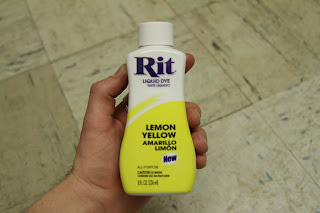
Tricks of the trade, eh? My plan was to take Hi-Con film, spool it up into a cylindrical form around a core (you know when it's 4 in the morning the night before a project's due and you're trying to coil your film around a core, and all you end up getting is cone made out of film, instead of the nice, neat, project-able spool? Like that...) and solarize the film for a brief second. I wanted to do this to mimic the effect given by a burn-in on film... a burn-in is merely light interacting with the emulsion, right? So that was my jumping off point, almost using the film in a resist-form with itself, as light had to past through the film to expose the underlying film.
I then processed the film as a negative. Hi-Con's great because you can process it either as a negative or as a reversal stock... and you can work with safe-lights. The photos in the darkroom didn't turn out (yuk yuk yuk), so I just have from the dyeing process onward.
Stuff works like a charm. My friend Jake called me earlier in the week, right after we'd gone over adding color to film in class and asked me if I wanted RIT dye his work was getting rid of. Talk about timing! Shoot!
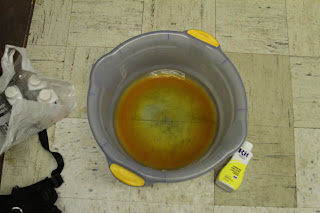
(Anyone else read the bit about processing film with piss in Recipes for Disaster? Tempting... haha.) But seriously, the dye kinda looks like stale urine, huh? Well, my friend Sarah said so anyway...
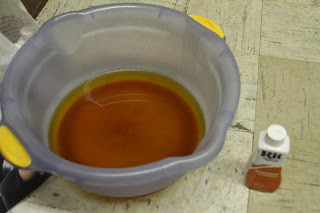
... so some tangerine got added. I was hoping to only dye selected parts of the film between the burn-in's I'd made, without any sort of resisting aides. Easier said than done.
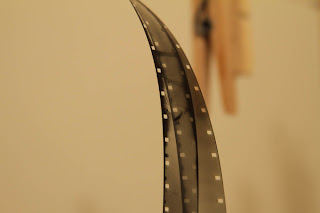 I got some pretty interesting looking burn-in/resists embedded within the film...
I got some pretty interesting looking burn-in/resists embedded within the film...
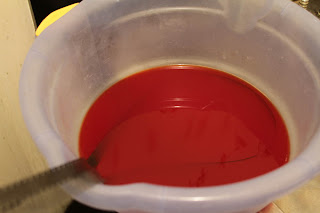
Time to try out this "selective dyeing" bit. Worked pretty well actually! But I got some help...
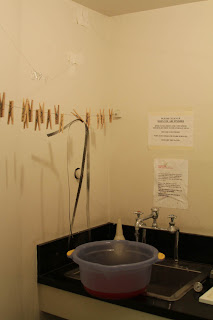
... from the clothes-pins. It's good to have another set of "hands" when you're trying to document and work on a project.
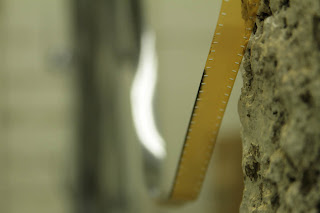
Well, I dyed the film for about 30 minutes, and pulled the sucker out to dry. The tangerine turned out well!
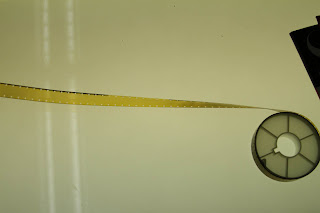
I spooled up this bad boy after it dried and headed home for some warm-water... both for some tea and some magazine transfers.
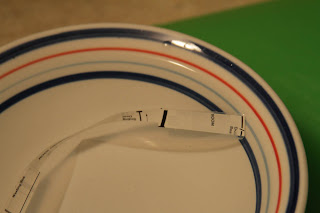
I tore the schemata into strips and began to soak in his hot water, ridding it of the paper backing it once had... I thought about this action figuratively as well, taking a formulation and in a sense, cleansing it, and reapplying it to another form. Transformation of ideas and presentation abound... or something to that degree.
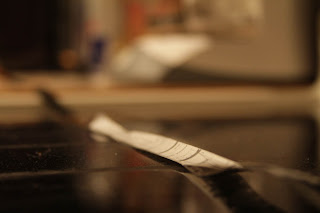
I let the magazine soak in the water for about 5 minutes and then plastered it onto spots that had become clear out of a burn-in.
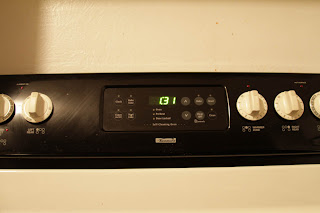
About bed-time? 8am class? 2 exams? About bed-time.
More magazine transfers to continue!
My intention with this film was to combine all the techniques covered in class thus far (subtractive method, additive, magazine transfers, COLOR) in some sort of visual exploration of the confusion I've been feeling lately... mainly towards my education at CU. I've been attending classes seemingly varied (physics, film, writing, history), but more so than learning the material, (which I'm trying to do as well) I've been studying how different departments convey their material to the student.
Hand processing film ain't really a new thing for myself, but magazine transfers are. This is my first attempt at this technique and in keeping with my theme of conveyance of material, I chose to transfer both the schematics of a darkroom set-up and explanations on how light functions physically. I've never cared for self-reflexivity in cinema work, but for some reason, I feel this approach is applicable to what I'm indirectly referring to with this loop.
Anyway, enough with the typing... y'all just want to see some photos right!? Here it go, goes.

Tricks of the trade, eh? My plan was to take Hi-Con film, spool it up into a cylindrical form around a core (you know when it's 4 in the morning the night before a project's due and you're trying to coil your film around a core, and all you end up getting is cone made out of film, instead of the nice, neat, project-able spool? Like that...) and solarize the film for a brief second. I wanted to do this to mimic the effect given by a burn-in on film... a burn-in is merely light interacting with the emulsion, right? So that was my jumping off point, almost using the film in a resist-form with itself, as light had to past through the film to expose the underlying film.
I then processed the film as a negative. Hi-Con's great because you can process it either as a negative or as a reversal stock... and you can work with safe-lights. The photos in the darkroom didn't turn out (yuk yuk yuk), so I just have from the dyeing process onward.
Stuff works like a charm. My friend Jake called me earlier in the week, right after we'd gone over adding color to film in class and asked me if I wanted RIT dye his work was getting rid of. Talk about timing! Shoot!

(Anyone else read the bit about processing film with piss in Recipes for Disaster? Tempting... haha.) But seriously, the dye kinda looks like stale urine, huh? Well, my friend Sarah said so anyway...

... so some tangerine got added. I was hoping to only dye selected parts of the film between the burn-in's I'd made, without any sort of resisting aides. Easier said than done.
 I got some pretty interesting looking burn-in/resists embedded within the film...
I got some pretty interesting looking burn-in/resists embedded within the film...
Time to try out this "selective dyeing" bit. Worked pretty well actually! But I got some help...

... from the clothes-pins. It's good to have another set of "hands" when you're trying to document and work on a project.

Well, I dyed the film for about 30 minutes, and pulled the sucker out to dry. The tangerine turned out well!

I spooled up this bad boy after it dried and headed home for some warm-water... both for some tea and some magazine transfers.

I tore the schemata into strips and began to soak in his hot water, ridding it of the paper backing it once had... I thought about this action figuratively as well, taking a formulation and in a sense, cleansing it, and reapplying it to another form. Transformation of ideas and presentation abound... or something to that degree.

I let the magazine soak in the water for about 5 minutes and then plastered it onto spots that had become clear out of a burn-in.

About bed-time? 8am class? 2 exams? About bed-time.
More magazine transfers to continue!
Thursday, January 28, 2010
Subscribe to:
Comments (Atom)

